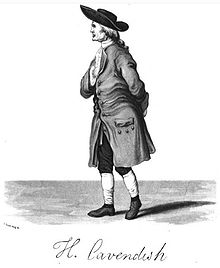Henry Cavendish FRS (/ˈkævəndɪʃ/; 10 October 1731 – 24 February 1810) was an English natural philosopher, scientist, and an important experimental and theoretical chemist and physicist. He is noted for his discovery of hydrogen, which he termed "inflammable air".[1] He described the density of inflammable air, which formed water on combustion, in a 1766 paper, On Factitious Airs. Antoine Lavoisier later reproduced Cavendish's experiment and gave the element its name.
A notoriously shy man, Cavendish was nonetheless distinguished for great accuracy and precision in his researches into the composition of atmospheric air, the properties of different gases, the synthesis of water, the law governing electrical attraction and repulsion, a mechanical theory of heat, and calculations of the density (and hence the mass) of the Earth. His experiment to measure the density of the Earth has come to be known as the Cavendish experiment.
Henry Cavendish | |
|---|---|
 Henry Cavendish | |
| Born | 10 October 1731 |
| Died | 24 February 1810 (aged 78) |
| Nationality | English |
| Citizenship | British |
| Alma mater | Peterhouse, Cambridge |
| Known for | Discovery of hydrogen Measuring the Earth's density (Cavendish experiment) |
| Awards | Copley medal |
| Scientific career | |
| Fields | Chemistry, physics |
| Institutions | Royal Institution |
https://en.wikipedia.org/wiki/Henry_Cavendish
The Cavendish experiment, performed in 1797–1798 by English scientist Henry Cavendish, was the first experiment to measure the force of gravity between massesin the laboratory[1] and the first to yield accurate values for the gravitational constant.[2][3] Because of the unit conventions then in use, the gravitational constant does not appear explicitly in Cavendish's work. Instead, the result was originally expressed as the specific gravity of the Earth,[4] or equivalently the mass of the Earth. His experiment gave the first accurate values for these geophysical constants.
The experiment was devised sometime before 1783 by geologist John Michell,[5][6] who constructed a torsion balance apparatus for it. However, Michell died in 1793 without completing the work. After his death the apparatus passed to Francis John Hyde Wollaston and then to Cavendish, who rebuilt the apparatus but kept close to Michell's original plan. Cavendish then carried out a series of measurements with the equipment and reported his results in the Philosophical Transactions of the Royal Society in 1798.[7]
https://en.wikipedia.org/wiki/Cavendish_experiment
No comments:
Post a Comment